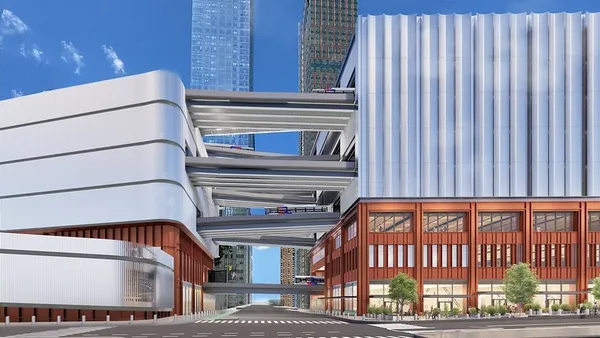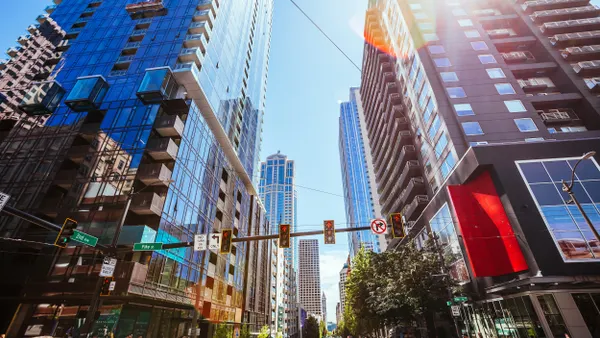This is a developing story.
Dive Brief:
- A leaked document obtained by Axios reveals what appears to be a six-page draft of the Trump administration's infrastructure plan. White House spokesperson Lindsay Walters would not confirm the document's validity to Axios, but said the administration anticipates revealing its infrastructure package "in the near future."
- According to the document, the Infrastructure Incentives Initiative, which incentivizes state, local and private investments in infrastructure with federal grants, makes up 50% of the plan's total appropriations; the Transformative Projects Program, which allocates federal dollars and assistance to "innovative and transformative" projects, accounts for 10%; the Rural Infrastructure Program, geared toward promoting investments in rural areas, accounts for 25%; Federal Credit Programs, which would expand existing federal lending programs to spur investment, make up 7.05%; and the Federal Capital Financing Fund, which would establish a financing system that parallels a budget, but would create a compulsory "revolving fund" to back federally acquired civilian property, accounts for 5% of the total.
- The plan would also see greater allowances for the use of private activity bonds (PABs), including in reconstruction projects, in order to encourage more private investment in public projects. The outline sees the AMT provision and Advance Refunding prohibition on PABs eliminated, as well as the removal of state and transportation volume caps on PABs.
Dive Insight:
Details of the $1 trillion infrastructure spend were supposed to be unveiled sometime this month, and the leaked document follows not long after murmurings, reported by Reuters, signaled President Donald Trump could reveal an overview of his sweeping $1 trillion infrastructure plan in his State of the Union address next week.
If the document is in fact part of the official draft, then Trump has returned to his campaign-era promise to focus on private investment for federal projects, after a slight pivot in September in which he suggested that public-private partnerships (P3s) were "more trouble than they're worth." The Associated General Contractors of America is still working with the administration to help officials understand the use of and applications for P3s, according to Brian Turmail, spokesperson for the organization.
"Assuming [the document] is authentic, we hope that there remains an as-yet-to-be-leaked plan to raise the funds for these new investments and that the funding plan includes a long-term fix to the Highway Trust Fund (HTF)," Turmail said. The HTF, which backs the largest share of money for state and local transportation projects, could run dry by 2020 without a stable source of funding. White House officials, including Transportation Secretary Elaine Chao, have floated the idea of raising the federal gas tax to better insulate the HTF, though those plans are likely to meet strong opposition.
While the Trump administration has alluded to $200 billion in federal coffers to get the plan off the ground, the draft puts no dollar signs on the sum the White House would kick in to jumpstart infrastructure, or where those investments would go. Previous reports have said $100 billion would go toward grants to aid local governments that produce their own funding, $50 billion would be allocated to rural infrastructure, $25 billion would be funneled into existing loan programs that encourage private investment, and the remaining $25 billion would fund transformative "American Spirit" projects like high-speed rail.
The apparent protection — and expansion — of PABs' status mirrors an earlier budget request by the president that called for lifting the cap on the amount of PAB financing private companies could acquire. The move also comes as a sign of relief to entities that rely heavily on the source to draw private investment. After Senate Republicans' tax bill threatened to terminate the bonds last month, Maryland officials announced the state would sell hundreds of millions of dollars' worth of PABs to secure a year of the tax-free funding endowed to developers by the program.
The president also appears to be keeping federal grants on the table for infrastructure projects — a provision that comes as good news for projects like Boston's and Minneapolis' light-rails. It's still unclear the extent to which grants will be offered as incentives for infrastructure investment, but, under the plan, grant awards will not exceed 20% of the project's total cost and individual states are not able to receive in excess of 10% of the amount available.
A final 70-page draft of the proposal could still surface sometime this month. And according to Trump policy adviser D.J. Gribbin, that outline will likely address mechanisms for streamlining the federal funding application process — a goal that Trump has touted since the run-up to his election.










